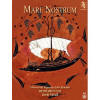Texte paru dans: / Appeared in: |
|
|
Reviewer: J.
F. Weber Two deluxe packages have been issued in a continuation of Jordi Savall’s interest in cultural history as it existed in the Iberian peninsula and as it is reflected in the wider Mediterranean world. Mare Nostrum, the Roman term for the Mediterranean Sea, is the seventh in an annual series of books of more than 450 pages (in this instance) and two (or in one case three) CDs slipped into the covers. In a reflection of the Christian, Muslim, and Jewish cultures that dwelt together in medieval Spain, the faithful of the same three religions are in dialog across the Mediterranean on these discs. Montserrat Figueras sang some of these tracks as recently as last July, when she was already ill. That is not at all evident in her singing, as haunting and evocative as ever. A Greek lullaby may be a remake (though it sounds identical to me) of one that she sang on Ninna Nanna, a touchingly lovely program (Fanfare 26: 6). She also sings a Sephardic song from Turkey with a cabalistic text, a Sephardic song from Tunisia, and a Spanish lullaby. She also has duets, two with Lior Elmaleh, an Israeli baritone who is featured with her; another duet is a Berber lullaby from Morocco. Elmaleh sings four Hebrew solos including a modern Israeli song. Other solo and ensemble songs are heard, and half of the 28 tracks are instrumental. Savall’s basic ensemble is joined by singers and players from Armenia, Turkey, Bulgaria, Israel, Greece, Morocco, and Palestine. Savall bends over backward to broaden his perspective, for I count only five tracks (two of them instrumental) that can possibly be labeled Christian. The notes are printed in 10 languages, three of them using non-roman alphabets, hence the 452-page book may be counted as 40 pages of notes. That undercounts the numerous color photos and illustrations, which are different throughout the book. The program is a remarkable compilation of music from all over the Mediterranean region, but don’t expect more than a couple of familiar tracks. This will be a new listening experience for most. The recordings were made in five locations between December 2009 and July 2011. The surround sound is realistic and the performances have the ring of authenticity that native artists bring to the music. The other package is a normal digipack but for the 250-page book that is bound in. This evocation of the Sublime Porte (the Ottoman court at Istanbul) not only uses most of the same musicians as Mare Nostrum, but it follows upon two previous issues, Orient—Occident and Istanbul—Dimitrie Cantemir (33:6), not to mention Jerusalem (32:5), another program that plays on this connection among the three faiths, which were all represented in Istanbul after its fall to the Turks. The Christians included the Greeks who had always lived there as well as an Armenian colony; the Sephardic Jews had recently been expelled from Spain; and the Moslems were the conquering Turks. All of these ethnic groups are represented on this program. On this disc, Figueras has only one song and one duet with Elmaleh, who also has a solo. Gürsoy Dinçer, a Turkish singer who had a single solo in the previous set, has five solo songs here and is featured with the other two singers in the credits. The tanbur player Dimitrie Cantemir (1673–1723), who was credited with seven works on an earlier disc that bore his name and four more works on Orient—Occident, is represented by another four works here. All of these may simply be some of the 355 works that he compiled in The Book of Musical Science. His name has also appeared on several other labels (Atma, Sony/BMG, etc.) in the last few years, but I have no idea how many of his own compositions have actually been recorded. Since the notes are printed in seven languages, the book amounts to 28 pages of notes, again undercounting the many color photos that are different throughout. Most of these tracks were recorded last summer, the rest a year earlier. This will also be a novel listening experience, since it has even fewer familiar tunes than the other set. Both sets continue the pattern of elegant presentation that marks all of Alia Vox’s releases. | |
|
|
|
|
Cliquez l'un ou l'autre
bouton pour découvrir bien d'autres critiques de CD |
|




